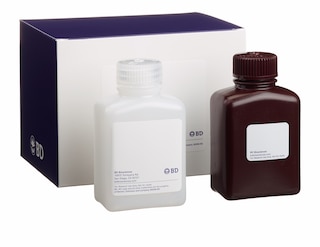-
Reagents
- Flow Cytometry Reagents
-
Western Blotting and Molecular Reagents
- Immunoassay Reagents
-
Single-Cell Multiomics Reagents
- BD® OMICS-Guard Sample Preservation Buffer
- BD® AbSeq Assay
- BD® OMICS-One Immune Profiler Protein Panel
- BD® Single-Cell Multiplexing Kit
- BD Rhapsody™ ATAC-Seq Assays
- BD Rhapsody™ Whole Transcriptome Analysis (WTA) Amplification Kit
- BD Rhapsody™ TCR/BCR Next Multiomic Assays
- BD Rhapsody™ Targeted mRNA Kits
- BD Rhapsody™ Accessory Kits
-
Functional Assays
-
Microscopy and Imaging Reagents
-
Cell Preparation and Separation Reagents
-
- BD® OMICS-Guard Sample Preservation Buffer
- BD® AbSeq Assay
- BD® OMICS-One Immune Profiler Protein Panel
- BD® Single-Cell Multiplexing Kit
- BD Rhapsody™ ATAC-Seq Assays
- BD Rhapsody™ Whole Transcriptome Analysis (WTA) Amplification Kit
- BD Rhapsody™ TCR/BCR Next Multiomic Assays
- BD Rhapsody™ Targeted mRNA Kits
- BD Rhapsody™ Accessory Kits
- United States (English)
-
Change country/language
Old Browser
This page has been recently translated and is available in French now.
Looks like you're visiting us from {countryName}.
Would you like to stay on the current country site or be switched to your country?


.png)

Detection of intracellular mouse IgG2b in an antibody-secreting hybridoma cell line. Cells were fixed, permeabilized, and stained according to the method described below using FITC Rat Anti-Mouse IgG2b (Cat. No. 553395; solid line histogram) or the matched isotype control, FITC Rat IgG2a, κ Isotype Control (Cat. No. 554688; dashed line histogram). Flow cytometry was performed on a BD FACSCalibur™ flow cytometry system.
.png)

BD Pharmingen™ FITC Rat Anti-Mouse IgG2b
.png)
Regulatory Status Legend
Any use of products other than the permitted use without the express written authorization of Becton, Dickinson and Company is strictly prohibited.
Preparation And Storage
Recommended Assay Procedures
Immunostaining and flow cytometry: FITC Rat Anti-Mouse IgG2b may be used as a primary or secondary reagent in immunofluorescent staining. For detection of intracytoplasmic IgG2b, please refer to the following protocol.
Immunofluorescent Staining of Intracellular Immunoglobulin (Ig) Protocol
1. Prepare a single-cell suspension and determine cell number.
2. Suspend cells in staining buffer (PBS + 2% FBS + 0.1% Sodium Azide, Stain buffer, Cat. No. 554656) at 2 × 10e7 cells/ml and transfer to U-bottom microwell plates in 50 µl/well for immunofluorescent staining.
3. Block Fcγ receptors by adding 0.2 µg of Purified Rat Anti-Mouse CD16/CD32 (Mouse BD Fc Block™), (Cat. No. 553141/553142) in 50 µl of staining buffer to each well.
4. Incubate 5 minutes on ice.
5. Add 200 µl of staining buffer/well and resuspend cells. Centrifuge at 250 × g for 5 minutes and aspirate supernatant.
6. Block surface Ig with Purified Rat Anti-Mouse IgG2b (Cat. No. 553392) by adding 1.0 µg per sample in 50 µl of staining buffer/well.
Note: Surface markers may be stained during this step as described in "Immunofluorescent Staining of Mouse and Rat Leukocytes for Flow Cytometry" under the protocols section of "Multicolor Flow Cytometry" at our website: http://www.bdbiosciences.com/us/s/resources.
7. Incubate 15 minutes on ice.
8. Wash 2X as described in Step 5.
9. Resuspend cells in 100 µl of BD Cytofix/Cytoperm™ intracellular staining buffer (BD Cytofix/Cytoperm™ Kit, Cat. No. 554714) per well.
10. Incubate 30 minutes at room temperature.
11. Wash 2X with 200 µl of 1X Perm/Wash buffer (provided in the BD Cytofix/Cytoperm Kit) per well. Centrifuge at 250 x g for 5 minutes and aspirate supernatant between washes.
12. Stain intracellular Ig by adding 1 µg of FITC Rat Anti-Mouse IgG2b in 50 µl of 1X Perm/Wash buffer/well. Note: Other antibodies recommended for staining of intracellular markers may be added during this step as described in Step 12.
13. Incubate for 30 minutes at room temperature.
14. Wash 2X as described in Step 11.
15. Resuspend and transfer samples in 100 µl of staining buffer to tubes appropriate for analysis with a flow cytometer. Bring volume in each tube to 400 µl with staining buffer.
16. Analyze samples on a flow cytometer.
Product Notices
- Since applications vary, each investigator should titrate the reagent to obtain optimal results.
- An isotype control should be used at the same concentration as the antibody of interest.
- Caution: Sodium azide yields highly toxic hydrazoic acid under acidic conditions. Dilute azide compounds in running water before discarding to avoid accumulation of potentially explosive deposits in plumbing.
- For fluorochrome spectra and suitable instrument settings, please refer to our Multicolor Flow Cytometry web page at www.bdbiosciences.com/colors.
- Please refer to www.bdbiosciences.com/us/s/resources for technical protocols.
Companion Products






The R12-3 antibody recognizes an epitope in the CH3 domain of mouse IgG2b of Igh-C[a] and Igh-C[b] haplotypes. It does not react with other Ig isotypes. Detection of surface immunoglobulin on B lymphoma cells has been demonstrated with R12-3 mAb.

Development References (1)
-
Wu K, Chen A, Tan P, Pan ZQ. The Nedd8-conjugated ROC1-CUL1 core ubiquitin ligase utilizes Nedd8 charged surface residues for efficient polyubiquitin chain assembly catalyzed by Cdc34.. J Biol Chem. 2002; 277(1):516-27. (Biology: Cell differentiation). View Reference
Please refer to Support Documents for Quality Certificates
Global - Refer to manufacturer's instructions for use and related User Manuals and Technical data sheets before using this products as described
Comparisons, where applicable, are made against older BD Technology, manual methods or are general performance claims. Comparisons are not made against non-BD technologies, unless otherwise noted.
For Research Use Only. Not for use in diagnostic or therapeutic procedures.